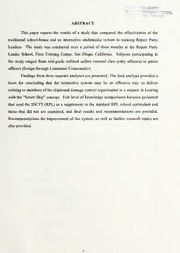Table Of ContentNPS ARCHIVE
1997
RICHTER, S.
NAVAL POSTGRADUATE SCHOOL
Monterey, California
THESIS
THE COMPARATIVE EFFECTIVENESS OF
CONVENTIONAL SCHOOL-HOUSE TRAININGVS.
INTERACTIVE COURSEWARE
by
Steven L. Richter
September, 1997
ThesisAdvisor: Samuel E. Buttrey
Thesis
R39565
Approved for public release; distribution is unlimited.
OXUBRARY
JGRADUATESCHOOL
CA C3943-5101
.
REPORT DOCUMENTATION PAGE
FormApproved
OMB
No. 0704-0188
Publicreportingburdenforthiscollectionofinformationisestimatedtoaverage1 hourperresponse, includingthetimeforreviewing instruction,searching
existingdatasources,gatheringandmaintainingthedataneeded, andcompletingandreviewingthecollectionofinformation. Sendcommentsregarding
thisburdenestimateoranyotheraspectofthiscollectionofinformation, includingsuggestionsforreducingthisburden,toWashingtonheadquarters
Services,DirectorateforInformationOperationsand Reports, 1215JeffersonDavisHighway, Suite1204,Arlington, VA22202-4302, andtotheOfficeof
Managementand Budget, PaperworkReductionProject(0704-0188)Washington DC20503.
1. AGENCY USEONLY (Leaveblank) 2. REPORTDATE 3. REPORTTYPEANDDATESCOVERED
September 1997 Master'sThesis
4. TITLEAND SUBTITLE 5. FUNDING NUMBERS
THE COMPARATIVEEFFECTIVENESS OF CONVENTIONAL SCHOOL-HOUSE
TRAININGVS. INTERACTIVE COURSEWARE
6. AUTHOR(S)
Richter, StevenL.
7. PERFORMINGORGANIZATION NAME(S)ANDADDRESS(ES) 8. PERFORMING
ORGANIZATION REPORT
NavalPostgraduate School NUMBER
Monterey, CA 93943-5000
9. SPONSORING/MONITORINGAGENCY NAME(S)ANDADDRESS(ES) 10.SPONSORING/
MONITORING
AGENCY REPORTNUMBER
11. SUPPLEMENTARY NOTES
Theviewsexpressedinthisthesisarethose oftheauthoranddonot reflect the official policyorposition oftheDepartmentof
DefenseortheU.S. Government.
12a. DISTRIBUTION/AVAILABILITY STATEMENT 12b. DISTRIBUTIONCODE
Approvedforpublic release; distributionunlimited
13. ABSTRACT (maximum 200 words)
This paper reports the results ofa study that compared the effectiveness ofthe traditional school-house and an
interactivemultimedia system intrainingRepair PartyLeaders. The study was conducted over a period ofthreemonths
at the Repair Party Leader School, Fleet Training Center, San Diego, California. Subjects participating in the study
ranged from mid-grade enlisted sailors (second class petty officers) to junior officers (Ensign through Lieutenant
Commander).
Findings fromthree separate analyses arepresented. The data analysis provides a basis for concludingthat this
systemmaybeaneffectivewayto delivertrainingto members ofthe shipboarddamage control organizationin a manner
inkeepingwiththe"Smart Ship" concept. Exitlevel ofknowledge comparisons betweenpersonnel that usedtheIDCTT
(RPL) as an augment tothe standard RPL school curriculum andthose that didnot are examined, and final results and
recommendations areprovided. Recommendations for improvement ofthe system, as well as further researchtopics are
alsoprovided.
14. SUBJECTTERMS 15. NUMBEROF
InteractiveDamage ControlTrainingTechnology,RepairPartyLeader,Damage ControlTraining PAGES
130
16. PRICECODE
1R7E.PSOERCTURITYCLASSIFICATIONOF 1T8H.ISSEPCAUGREITYCLASSIFICATIONOF A19B.SSTERCAUCRTITYCLASSIFICATIONOF O20F.ALBISMITTRAATCIOTN
Unclassified UL
Unclassified Unclassified
>N7540-01-280-5500 Standard Form298(Rev.2-89)
PrescribedbyANSIStd.239-18
11
Approved for public release; distribution is unlimited
THE COMPARATIVE EFFECTIVENESS OF CONVENTIONAL SCHOOL-HOUSE
TRAINING VS. INTERACTIVE COURSEWARE
Steven L. Richter
Commander, United States Naval Reserve
B.S., United States Naval Academy, 1981
Submitted in partial fulfillment ofthe
requirements for the degree of
MASTER OF SCIENCE IN OPERATIONS RESEARCH
from the
NAVAL POSTGRADUATE SCHOOL
September 1997
OXLIBRARY
VTGRADUATESCHOOL
CA
<a943-S101
ABSTRACT
This paper reports the results of a study that compared the effectiveness ofthe
traditional school-house and an interactive multimedia system in training Repair Party
Leaders. The study was conducted over a period of three months at the Repair Party
Leader School, Fleet Training Center, San Diego, California. Subjects participating in
the study ranged from mid-grade enlisted sailors (second class petty officers) to junior
officers (Ensignthrough Lieutenant Commander).
Findings from three separate analyses are presented. The data analysis provides a
basis for concluding that the interactive system may be an effective way to deliver
training to members ofthe shipboard damage control organization in a manner in keeping
with the "Smart Ship" concept. Exit level ofknowledge comparisons between personnel
that used the IDCTT (RPL) as a supplement to the standard RPL school curriculum and
those that did not are examined, and final results and recommendations are provided.
Recommendations for improvement ofthe system, as well as further research topics are
also provided.
VI
TABLE OF CONTENTS
INTRODUCTION
I. 1
H. BACKGROUND OF INTERACTIVE LEARNING 3
A
CONCEPTS OF INTERACTIVE MULTIMEDIA USED EN
EDUCATIONAND TRAINING
3
B. APPLICATIONS OF COMPUTER-BASED, INTERACTIVE
AND MULTIMEDIA INSTRUCTION
5
C PREVIOUS FINDINGS
5
D. IDCTT (RPL) SYSTEM DESCRIPTION 6
E. PRIMARY GOAL OF EDCTT (RPL) 10
F. FEATURES AND BENEFITS OF IDCTT (RPL) 10
G. IDCTT (RPL) TEACHINGPOINTS 11
ffl. THE REPAIRPARTY LEADER. 13
A. REPAIRPARTY LEADERTRAININGPROGRAM 14
1. Current Practice 14
2. Repair Party Leader School Instructors 15
3. Instruction atthe Repair Party Leader School. 15
4. Written Examinations Administered at the Repair Party Leader
School 16
B. PERSONNEL QUALIFICATION STANDARDS 17
METHODOLOGY
IV. 19
A
EXPERIMENTAL DESIGN 19
1. Assignment ofStudents 19
a. March and April Classes 19
b. May Class 20
2. Entrance Data 21
3. Implementation ofthe Experiment 21
B. STUDY SAMPLE 22
C METRICS 23
1. Variables 23
vu
2. ComputerAptitude Index (CAI) 24
V. DATA ANALYSIS AND RESULTS 27
A. SAMPLE DEMOGRAPHICS 27
B. ANALYSIS OF THE COMPLETE DATA SET 33
1. Variable Selection 33
2. Initial Data Analysis 35
a. Control Group Analysis 36
b. Treatment Group Analysis 36
c. Combined Analysis 37
3. Analysis ofVariance 38
4. Hypothesis Testing 40
5. Analysis ofResults 44
C. ANALYSIS OFDATA COLLECTED DURINGMAY 1997
RPL SCHOOL CLASS 45
1. Variable Selection 46
2. Distribution ofthe Data 46
3. Initial Data Analysis 48
4. Analysis ofVariance 50
5. Hypothesis Testing 51
6. Analysis ofResults 53
D. ANALYSIS OF CENSORED DATA SET 53
1. Variable Selection 54
2. Analysis ofVariance 55
3. Hypothesis Testing 57
4. Analysis ofResults 60
E. SUMMARY OF RESULTS 60
VI. CONCLUSIONS AND RECOMMENDATIONS 63
A. CONCLUSIONS 63
B. RECOMMENDATIONS FOR IDCTT (RPL) IMPROVEMENT 64
RECOMMENDATIONS FORFURTHER RESEARCH
C. 66
APPENDIX A. IDCTT (RPL) TEACHINGPOINTS 69
APPENDIX B. STUDENT ENTRANCE DATA SHEET AND PRE-TEST 77
APPENDDC C. ORAL BOARD QUESTIONS AND PROCTOR INSTRUCTIONS 89
. .
VHl

